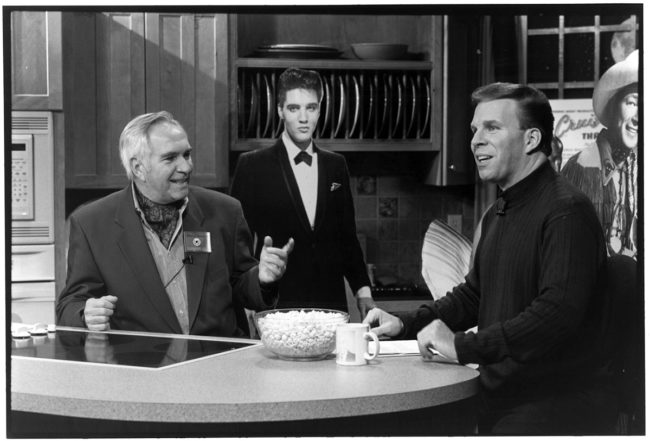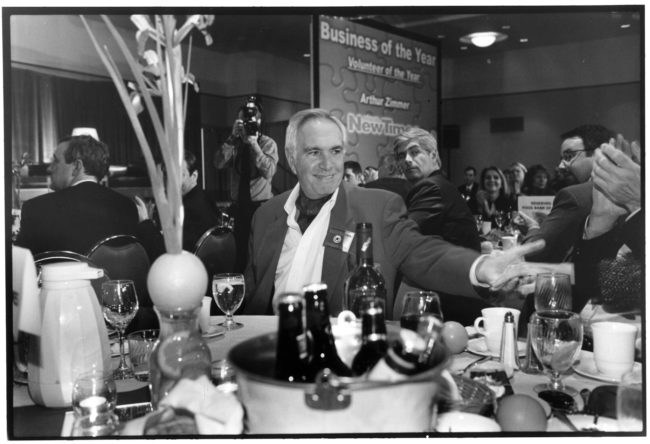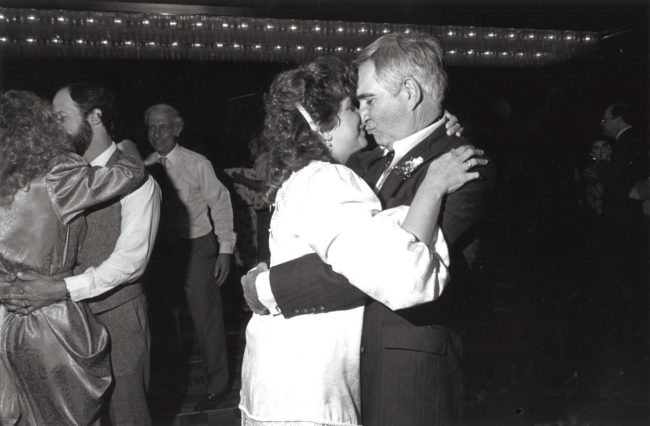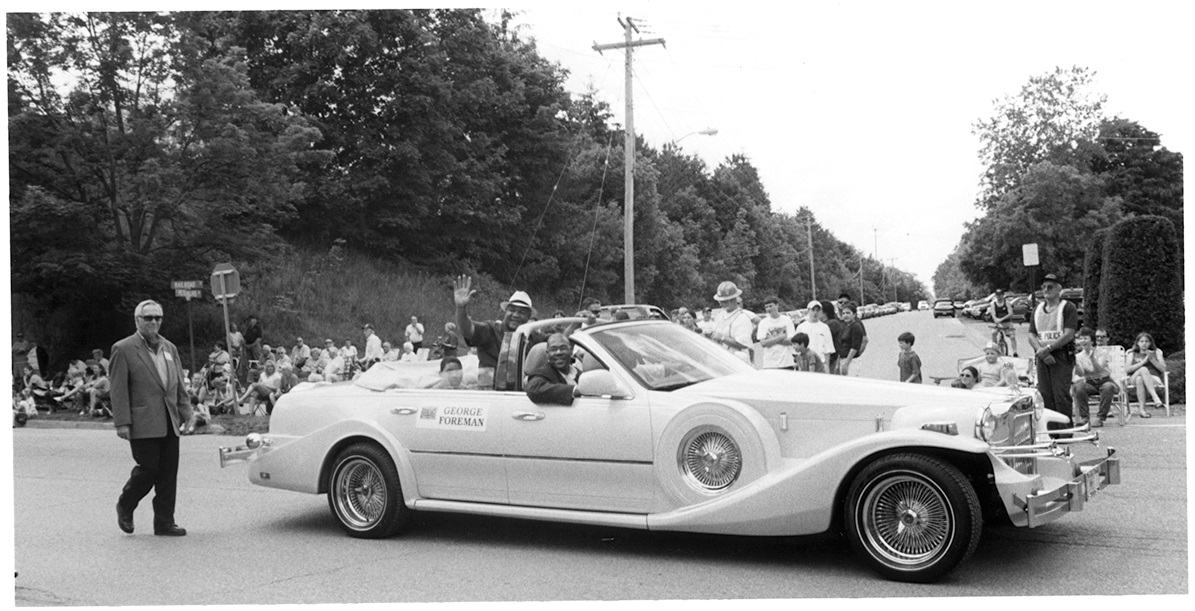In “The Art Issue,” printed in the Sept. 9, 2009, issue, publisher Art Zimmer celebrated his 25th year of Syracuse New Times ownership with a sit-down interview. Zimmer came along at the right time to ensure the paper’s survival, yet he had his own unusual reason for buying the alternative newsweekly.
Twice since he founded the Syracuse New Times in 1969, Ken Simon sold part ownership of the paper, first to Ed Green and other local investors and then to the Advocate Newspapers, a chain of alt-weeklies in Massachusetts, Connecticut and Westchester County. In 1981 the Advocate owners gained control from Simon, and they appointed as publisher Syracuse University law school graduate Peter Orville. Out-of-town ownership eventually crippled The New Times, as its page count, ad sales and circulation all plummeted, and Advocate owners were on the cusp of shutting down the operation.
Everything changed in August 1984 when Zimmer took over The New Times both as an investment and as a vehicle to publish his wintertime ski column, which had just been dropped by The Post Standard. Zimmer’s “On the Slopes” column appeared in these pages until 1991.
Zimmer touched upon a flurry of memories for this interview, especially his romance with the former Shirley Sherburne, who is still Mrs. Z to his Arturo Z:
I grew up on a Hamilton farm milking cows and bailing hay. After the farm, I joined the Army. I was there for three years active duty, three years active reserve and was stationed all over. I went from here to Texas and back a couple of times which was a lot of travel for a very naïve and innocent little farm boy that had gone nowhere and done nothing. It was quite an experience to travel all over the United States when I was in the Army and it opened my eyes that there was more to the world than cows.
In high school, because we were extremely poor and farming was a tough business, I had to stay home and work the farm a great deal and was never able to take part in school activities and was never able to play sports because I had to work. I wasn’t much of a scholar at all; there were 43 people in my class and I graduated 43rd and came very close to not graduating at all. They graduated me because they wanted to get rid of me because I wasn’t much of an asset to the school.
I hitchhiked to Syracuse in 1962 with just $18 in my pocket and knew nobody and had no contacts. I didn’t plan on staying here very long. I latched onto a fairly decent job with the National Biscuit Company (Nabisco) selling cookies and crackers, which was one of the best jobs I’ve ever had in my life. I was there about five years and it was a good job because each morning we’d go in and they’d give us a box of samples to go out and use on our sales. So I’d go out in the morning and sell them like hell and then eat the samples for lunch. I had no money, so I lived on sample boxes for about a year until I started doing well and getting a little bit of money ahead.

Art Zimmer is the guest chef with Ron Curtis Jr. during a 2002 installment of “Freaky Flix and Food” (Michael Davis/Syracuse New Times)
I was also looking for some social contacts and I had heard about the Onondaga Ski Club. I wasn’t a skier, but I joined that first winter and found that it was a really wonderful organization and I got really involved and went on to become president of it. I ran the whole club for about 20 years and when I joined they had about 800 members and after I became president and head of marketing and such, I brought the club up to about 1,600 members.
My first experience in the newspaper business was at The Mid-York Weekly, the hometown weekly newspaper in Hamilton. I was a member of the Boy Scout troop and I got elected to a position called “scribe,” which nobody knew what it was. I was 11 or 12 years old and they said they needed somebody to tell people about the scout troop and what they’re doing. So I went over to The Mid-York office and they said, “Just write about what the scout troop is doing and give it to us.” So I did that for about four years and they were publishing my articles every two or three weeks and I still have a scrapbook full of those articles. That was my career with The Mid-York Weekly.
With Brown Newspapers, the forerunner to the Eagle Newspapers, I was actually a sales rep selling advertising. So I convinced the publisher to let me write a column about the businesses that were advertising as free publicity for them.
Then I was the ski editor of The Post-Standard from 1978 to 1983. Because I was president of the ski club, I had been the founder of the big ski show that was out at the New York State Fairgrounds that ran there for 20 years, which I was the director of for 16 years. I grew it from zero to the largest ski show in the United States and, as a pure ski show, it was bigger than the ones in New York City and Chicago. We filled the entire Center of Progress building and it was quite the extravaganza for years.
We were always trying to get The Post-Standard to write ski articles and they were never interested. They did throw us a little bone in January and February for eight weeks when they would run a weekly column about what was going on in the ski world.
One day I picked up the paper to read the ski column and it wasn’t there. So I called up the paper and talked to the sports editor at the time, Bob Atkinson, and Bob said, “The person that was writing the ski column has left town and we don’t have anyone else on staff interested in skiing so we probably won’t bother having a ski column anymore.” And I said, “Look, if you want someone to write a ski column, I’m president of the Onondaga Ski Club and was an instructor at a ski school and was on a race team and have worked at ski shops and did the ski show and basically knew everything that was going on with skiing in Central New York.” And he said, “Oh, that sounds good. Do you know how to write?”
Well, I was faced with a decision: Do I tell a little white lie, the first one of my entire life? Or tell him the truth and have the conversation be over? So I said, “Well, sure I can write,” and he said, “OK you can write the ski column.” So home I go and write the first ski column and drop it off and tell all my friends, “Hey, I’m now the ski editor at The Post-Standard.” So Thursday morning I pick up the paper and there’s no ski column. So I called Bob Atkinson and said, “Where’s my column?” He said, “That piece of garbage? You can’t write! We couldn’t print that!” He said they didn’t have time to edit the article and that they’ve got to look at it for 30 seconds and it goes in the paper, and that I was done, finished.
I drove down and walked into Bob’s office and literally dropped down on my knees in front of his desk and said, “Please, you’ve got to help me.” So we talked a bit and he said, “OK, Art, I’ll make an exception. If you turn in your ski column three or four days early, I’ll spend a little time and clean it up and make it printable,” and that’s what we did.
So now I’m a ski editor and a ski writer, and then I found out about the United States Ski Writers Organization, a group of top-quality professional ski writers for the national ski magazines and big daily newspapers. They only had two requirements for membership. One requirement was that you had to be a paid ski writer. The Post-Standard was paying me $10 a column and I was doing eight columns in January and February, so I was getting $80 a year. The second requirement was that you had to write at least eight columns per year, which I was.
So I applied for membership and now belonged to the most prestigious ski writers association in the United States. Every ski area in the world wants you to come there in hopes you will write about them and that it’s carte blanche with everything. I had six all-expense paid trips to Europe by the Austrian National Tourists Office and the Swiss National Tourists Office. I traveled all over the United States to every ski area and I wrote about these places, so I was living the life of Riley for an average skier.
Meanwhile, my day job and business at that point was real estate: I’d buy old junky buildings and fix them up and rent them out, doing all the work myself. And since I was working for myself, I had lots of time and a flexible schedule that I could go on these trips and it was great.
So everything is rolling along fine for several years until Bob Atkinson got promoted as an executive editor at The Post-Standard. So in comes this new sports editor, and he called me up and said, “Art, I know what Atkinson’s been doing with you and I’m not going to do it. You’re done, finished, fired.” So I thought, “What am I going to do now? I’m going to get kicked out of the ski writers association.”
There was The Herald-Journal, but they had a very talented ski writer who was already writing a weekly column and was a friend of mine that went on a lot of these trips with me, so there was no opening there. And the other problem was that I can’t write.
But there was this publication that I never read or didn’t know anyone else that read it, called The New Times. And when you’re desperate, you’ll do desperate things. So I went down there and I said, “How would you guys like the former Post-Standard ski editor on your staff?” I told them they only had to pay me $10 a week and they thought that was great. But then they told me even at $10 a week, forget it, because they were bankrupt and going out of business.

Zimmer prepares to accept the Volunteer of the Year Award from the Greater Syracuse Chamber of Commerce in March 2004. (Michael Davis/Syracuse New Times)
So I thought my life with the ski writers association was over and for about two weeks I wandered around town in a daze. And then I’m driving down Route 81 one afternoon, and just before I got to LaFayette, there’s a place every time I drive by that I still look at and smile. It’s a place where it says, “No U-Turn” and it hit me clear as a bell and I thought, “I know what I’ve got to do.” So I made the U-turn and drove to The New Times office. They said they’ll be closing either the next week or two and that’ll be it. So I said, “Fine, I’ll buy the place, name myself ski editor and I’ll live happily ever after.” And that’s the true story of how I bought The New Times.
My first issue as the publisher was the first issue of September 1984. Now, I was doing all right with the real estate, but was not wealthy by a long shot and couldn’t afford to have a money-losing business just for the sake of publishing my ski column. My fondest dream was to bring it up and break even. Circulation was about 3,000 and staff was three unpaid people and rent in the office hadn’t been paid in six months and the landlord had eviction papers already drawn and was getting ready to put us out on the street.
And since I couldn’t afford to have a money-losing business, I rolled up my sleeves and went to work and put some time and effort into it. I swung the paper from being left-leaning liberal to being a little more centered and more of a community paper than it ever had been.
We went from 3,000 to 40,000 circulation and an unpaid staff of three to 25 full-time employees. And we went from grossing under $200,000 per year to over $2 million a few years later. About a year after I bought The New Times, I asked photographer Mike Davis, “What’s the big difference around here since I came on board?” And he said, “Our paychecks don’t bounce anymore.”
When I bought The New Times, it was in a rented office down in Armory Square. After settling up with the landlord, after a year or two, I decided that The New Times should have its own building. One thing most people don’t realize is that The New Times was the original business in Armory Square and set the trend. Being a funky, crazy, far-out business, you could say we were the founders of Armory Square.
I thought it would be important to stay in Armory Square, but there was one major problem: There was no parking. So I couldn’t find anything downtown, so this office (1415 W. Genesee St.) ended up being the best choice where we had parking and it was as close to downtown as possible and on a bus line.
Regarding the Zimmer Motor Car Co., one day I happen to see a fancy car parked in front of Sam Dell Dodge, so I stopped and looked at it and said, “Wow, it’s called a Zimmer.” And that was the end of that. Then about a year later, Shirley and I were on a trip to a newspaper convention and saw a Zimmer in a used car showroom. I took it for a test drive just to have fun. Shirley insisted that we buy and I said, “No, I don’t buy toys. If I had a few spare dollars I’d invest it into The New Times.”
But then I found out the Zimmer company was bankrupt and closed. I said somebody should manufacture this car because it had my name on it. So I bought it and started the Zimmer Car Co. because it had my name on it. Now Shaquille O’Neal has one, Hulk Hogan, Willie Nelson and Lou Rawls, who passed away a couple of years ago, bought two of them.

Happily ever after: Art and Shirley Zimmer during their August 1987 wedding reception. (Michael Davis/Syracuse New Times)
Shirley and I were fixed up by mutual friends on a blind date and went out to dinner with them, which was 22 years ago. It was a raging blizzard that night and she thought I’d call her up and cancel the date. So she called her friend who was fixing her up and said, “It’s a blizzard out there, are we still going out to dinner tonight?” And my friend, who was also an avid skier in the ski club, said, “Those guys are skiers, they’ll drive through anything.”
That first date was Jan. 23, 1987. And after dinner that night, my friend said to his wife, “Don’t you ever fix one of my friends up with your friends again. They didn’t like one another.” Then about three weeks later, Shirley and I went to visit them and told them we were engaged to get married. And six months later, we were married.
[fbcomments url="" width="100%" count="on"]















